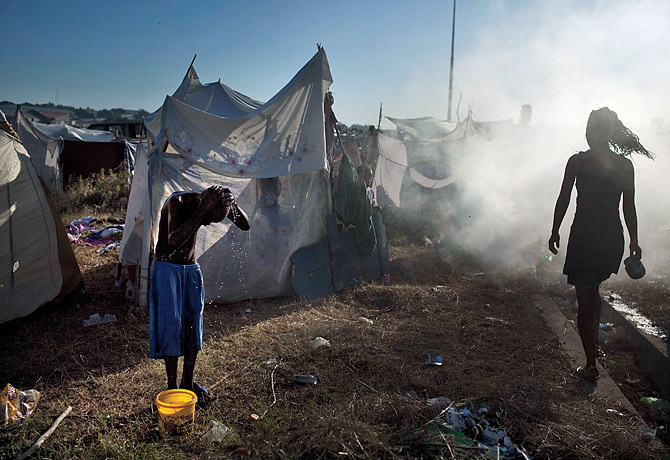
More than 1.5 million Haitians lost their homes in the Jan. 12 quake, leaving even makeshift tents in scarce supply.
Michaud Jonas returned to the ruins of the Palm Apparel factory to see if he could find his little sister's body — and, possibly, a job. Hundreds of workers were buried under the rubble of this T-shirt-manufacturing plant in the Port-au-Prince suburb of Carrefour, and Jonas' sister, 22, was one of them. The scent of decay around the neighborhood was overpowering. Yet though he mourned his loss — his brother and mother also died, when the family's home collapsed — he looked ahead. "Here was the worst place hit, so maybe it'll be the first place to recover," he said. "I need to find a job so I can help what's left of my family. They are depending on me."
Haiti is a country in agony. More than a week after a 7.0-strength quake leveled Port-au-Prince and its surroundings, rescue teams kept combing the ruins for survivors — and some were miraculously found after days in the rubble — but hope was slowly dwindling. International help began to pour into Haiti, but with the capital and most political infrastructure destroyed, the aid wasn't nearly enough. Emergency medical teams operating out of shipping containers worked to save limbs and lives, and desperate requests went out to U.S. medical schools for more volunteers. More than 1.5 million Haitians are homeless, and the full death toll — perhaps 100,000 or more — remains unknown and may be unknowable, as tens of thousands of corpses were delivered to mass graves without ceremony. As if that weren't bad enough, a 6.1-magnitude aftershock rocked Haiti on Jan. 20, further rattling nerves. "This is really an unprecedented situation," says U.N. Secretary-General Ban Ki-moon. He feels it personally. The U.N. lost more than 40 people in the quake, the worst disaster the global body has suffered in its 65-year history. "It is overwhelming — overwhelming."
As rescue work shifts to recovery work, it will take a monumental effort from the international community — and the shell-shocked Haitian people — to prevent the catastrophe from growing even worse. Yet Haiti, the poorest country in the western hemisphere, can't and shouldn't simply be restored to what it was before the quake. The catastrophic death toll was a result not so much of the earthquake's strength but of Haiti's history of corruption, its shoddy buildings and ultimately its poverty. As we've seen in the aftermath of previous disasters, rebuilding takes time, commitment and sustained funding — and in Haiti's case, they're especially important. What's at stake goes beyond that nation's shores. Unless the world helps prepare the poorest societies for future quakes and storms — through better buildings, better government infrastructure and sustained growth — we'll be chasing after worsening disasters for decades to come. "It would be unconscionable to turn Port-au-Prince back to the way it was," says John Mutter, a seismologist at Columbia University. "You have to use this as a perverse chance to build back better."
For all the uncertainty and chaos in the early days following the quake, it was clear the world wanted to help. From the high-level work of former President Bill Clinton, the U.N. special envoy to Haiti, to the millions of dollars donated through text-messaging, there was no shortage of generosity in response to the devastation. Americans alone gave more than $190?million in the first week after the quake, on track with the response to the 2004 tsunami and Hurricane Katrina. While the U.S. military prepared a large mobilization of troops and support staff, NGOs with a long history of responding to natural disasters moved into Haiti as fast as they could. "We will be here today, tomorrow and for the time ahead," Secretary of State Hillary Clinton said on Jan. 16.
But that willingness to help collided at first with what was a logistical nightmare. Port-au-Prince's seaport was rendered unusable, its airport was barely functional, and roads were snarled by debris and the homeless. The temblor not only struck a country mired in poverty; it erupted just 15 miles (about 24 km) from that nation's capital. The result was a bureaucratic decapitation, meaning aid and personnel initially had to be shipped in, either through the neighboring Dominican Republic or secondary airports in Haiti. (The Asian tsunami, by contrast, didn't touch the capitals of affected countries.) Even after the Port-au-Prince airport was partly repaired and under the control of the U.S., landing slots were tight; some NGOs claimed that humanitarian flights were turned away for lack of space (though the U.S. insists that was only temporary). And for the locals, there was no Plan B. "With Katrina, if you could walk to the edge of a disaster area, you could get in a car, drive 40 miles, find a store and buy what you needed," says Caryl Stern, president and CEO of the U.S. fund for UNICEF. "Here, there is no car. There is no highway. There is no 40 miles away."